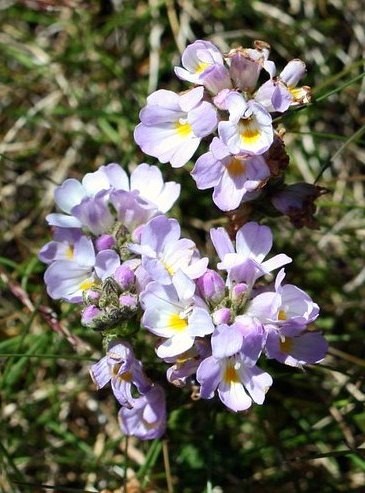Purple eyebright
(Euphrasia collina gunnii)

Description
Euphrasia collina is a perennial herb or subshrub in the genus Euphrasia. Plants grow to between 5 and 60 cm high and have leaves with 1 to 6 teeth per side. The flowers may be white, blue, pink or purple, sometimes blotched with yellow on the lower petal. It occurs in South Australia, Victoria, Tasmania and New South Wales in a wide variety of habitats including woodland, heath and grasslands, from coastal to alpine areas. Euphrasia, or eyebright, is a genus of about 450 species of herbaceous flowering plants in the family Orobanchaceae (formerly included in the Scrophulariaceae), with a cosmopolitan distribution. They are semi-parasitic on grasses and other plants. The common name refers to the plant's use in treating eye infections. Many species are found in alpine or sub-alpine meadows where snow is common. Flowers usually are borne terminally, are zygomorphic, and have a lower petal shaped like a lip. The most common flower colours are purple, blue-white, and violet. Some species have yellow markings on the lower petal to act as a guide to pollinating insects. Alternative names, mainly in herbalism, are Augentrostkraut, Euphrasiae herba, Herba Euphrasiae and Herbe d'Euphraise. The plant was known to classical herbalists, but then was not referred to until mentioned again in 1305. Nicholas Culpeper assigned it to the Zodiac sign Leo, claiming that it strengthened the brain. It was also used to treat bad memory and vertigo. In the Elizabethan era, the plant was used in ales, and Gervase Markham's Countrie Farm (1616) said that one should "Drinke everie morning a small draught of Eyebright wine. Herbalists use eyebright as a poultice with or without concurrent administration of a tea for the redness, swelling, and visual disturbances caused by blepharitis, and conjunctivitis. The herb is also used for eyestrain and to relieve inflammation caused by colds, coughs, sinus infections, sore throats, and hay fever. Parts used include the leaf, the stem, and small pieces of the flowers. Typical preparations include a warm compress, or tea. Eyebright preparations are also available as an extract or capsule. A 2010 report from the European Medicines Agency on the efficacy of Euphrasia remedies states: From the presence of secondary metabolites, an astringent and anti-inflammatory activity can be hypothesized for Euphrasia preparations. The ocular use of Euphrasia is based upon tradition.
Taxonomic tree:







